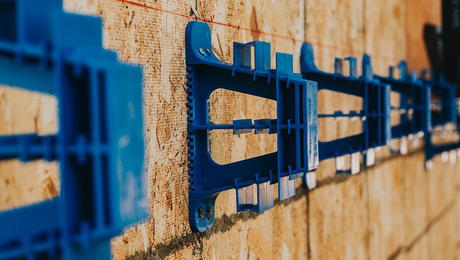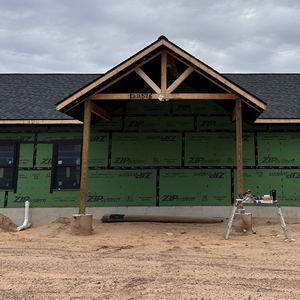Can anyone here tell me what a tributary diagram would look like for a hipped roof on a covered porch? This would be a stick-framed roof, of course, not trussed.
Discussion Forum
Discussion Forum
Up Next
Video Shorts
Featured Story

Discover a cost-effective system for applying continuous insulation that can help you achieve targeted R-values.
Featured Video
SawStop's Portable Tablesaw is Bigger and Better Than BeforeHighlights
"I have learned so much thanks to the searchable articles on the FHB website. I can confidently say that I expect to be a life-long subscriber." - M.K.
Fine Homebuilding Magazine
- Home Group
- Antique Trader
- Arts & Crafts Homes
- Bank Note Reporter
- Cabin Life
- Cuisine at Home
- Fine Gardening
- Fine Woodworking
- Green Building Advisor
- Garden Gate
- Horticulture
- Keep Craft Alive
- Log Home Living
- Military Trader/Vehicles
- Numismatic News
- Numismaster
- Old Cars Weekly
- Old House Journal
- Period Homes
- Popular Woodworking
- Script
- ShopNotes
- Sports Collectors Digest
- Threads
- Timber Home Living
- Traditional Building
- Woodsmith
- World Coin News
- Writer's Digest


















Replies
From the center point of the hip rafter, draw a square where the opposite corner is the top or bottom of the hip rafter.
Mike,
I've made a sketch of what I think you're saying.....
Square is drawn with center, D, at midpoint of hip rafter.
So is the shaded area the tributary on the hip rafter?
View Image
Well, what I was saying is go from point D to the midpoint of A-C to point C to the midpoint of C-E and back to point D.
But, then I drew it out and realized it's like this:
View Image
Half of the load of each rafter bearing on the hip is attributed to the hip.
Edited 8/15/2007 9:31 pm ET by Mike_Maines
Mike and Gene,
Thanks for the help -- the kite shape makes sense.
I'm also very interested in the load on beam AB (there's a post at B, of course). Is the tributary for beam AB the triangle ABG?
I'm figuring that triangle ACG represents the load carried by rafter AC, which would be nailed to the house wall.
Did either one of you study this in a CE class, or have you just sort of picked it up along the way?
View Image
You are correct in both your assumptions. For ease of calculation, I might eliminate the kite shape and change point G to the midpoint of AC, but it wouldn't be as accurate.
Gene is correct in telling you not to worry about the slope of the roof. These loads are all calculated in plan view.
Gene and I both went to school for engineering. I don't know about him, but I've been a carpenter since graduation. We didn't study hip roofs in school, it's all about bridges and skyscrapers, but I did learn how to determine tributary loads. Apparently I still need to draw things out to see them clearly, though ;-)
I believe the method described for you is wrong.The structure is statically indeterminate.One really needs to do a much more complex analysis - a virtual displacement method usually works.
Can you describe that method of calculation in general terms?
In general terms ---Perhaps.The forces on the hip rafter/jack rafter connection consist of the "tributary" roof load transfered by the jack rafter plus a force along the axis of the jack rafter.For our purposes the force along the axis of the jack rafter has a vertical component that supports the hip rafter.The method of computing this supporting force and the resulting stress and deflection would require much more space and time than I have to devote.Suffice it to say that you can remove both the top and bottom support for a hip rafter and the deflection and stress will be almost unchanged.
Thanks for your comments -- I appreciate your time.
What you're saying seems to get at a disagreement about how people view the loading on a hip rafter. It seems that many engineers these days specify a hip rafter that is significantly larger than what carpenters have used as a rule of thumb for many decades.
That aside, how would what you're saying affect the load on beam AB? What would a more accurate load diagram look like?
Hire an engineer.
Are you a structural engineer?
I am indeed a structural engineer.---If your design fits the prescriptive code, you don't need to ask your hip question.If it does not fit the prescriptive code, the engineering is well beyond your ability. And that meens you hire an engineer.
I am indeed a structural engineer.
Good -- I just wanted to be sure that I was speaking with someone who had daily experience with this kind of thing.
Actually, the engineer has already been hired, and the calculations have already been performed for this project. The only reason I'm asking these questions is that I'm curious and want to understand more about how the structure is analyzed.
I'm actually an engineer myself, albeit mechanical. So although I studied statics and basic beam loading and deflection, I was never exposed to the same level of analysis that the CEs go through.
So, with that background, I'm still wondering about the methods that you yourself use to analyze a hip roof. It sounds like there may be more than one way to interpret the loading on a hip rafter. Does your method result in a tributary diagram, or is it simply a different approach?
"It sounds like there may be more than one way to interpret the loading on a hip rafter."There are all manner of ways to interpret the loading on hip roofs. An engineer selects one and comes up with construction details to handle it.I prefer to view a roof as a set of flat plates, and then solve plate problems rather than beam problems. Uses much less material. Produces a better match between the engineered answer and the actual answer.
"The forces on the hip rafter/jack rafter connection consist of the "tributary" roof load transfered by the jack rafter plus a force along the axis of the jack rafter."Which also changes the perspective of the stresses at the bottom of the jacks from straight down to sliding off the plate. That is not the way roofs are built.All stresses in conventionaly framed and truss roofs are a vertical force on the plates. That's the purpose of collar ties.There should be no lateral forces from the plate to the hip along the jack. Mike is right. Furthermore, I, in my infinite wisdom, say, in an upper class British accent, that the ridge is carrying the top half of the hips load, not the upper jacks.Actually, if we were infinitely nit picky, there probably is some lateral loading in the middle of the hip span at the jack connection. This lateral load would then be opposed by the roof sheathing.SamT
All stresses in conventionaly framed and truss roofs are a vertical force on the plates. That's the purpose of collar ties.
Are you making the above comment in the context of a conventional gable roof? If so, I hear what you're saying, but even with collar ties, if the rafters are undersized and thus flex under load, isn't there some lateral force applied to the plates?
There should be no lateral forces from the plate to the hip along the jack
I think a parallel argument can be made here. One the one hand, if the hip rafter is modeled as a rigid beam (i.e. neglible deflection), then the jacks are vertically supported by the hip and the plates. There is no lateral loading on the plates in this arrangement.
On the other hand, if the hip rafter is not modeled as a rigid beam, then deflection of the hip rafter allows the upper ends of the jacks to drop in elevation, producing an outward thrust at the plates.
Does that interpretation hold water?
Thanks for your comments -- I'm still learning about framing loads and appreciate the discussion here.
"even with collar ties, if the rafters are undersized and thus flex under load, isn't there some lateral force applied to the plates?"Depends where the collar ties are attached to the rafter. If at the plate, and we're using an ideal collar tie, and ideal connections, NO. If elsewhere in the bottom third, then yes."Does that interpretation hold water?"Yes.
~Wood is not unobtanium, it is a twisting, shrinking, bending, sagging, expanding material. Nails and hangers, likewise change their dimensions and other charcteristics with changes in the environment.Engineering is a science of average minimums, aproximations, and probable maximums. A butterfly landing on an eave will move the walls at the other end of the house. Maybe only the width of a hydrogen molecule, but it will move.The way roofs are framed, with a rafter birdsmouth sitting on top of a plate and a ceiling joist/collar tie attached to the bottom of the rafter, any lateral force/movement is miniscule in relation to the verticle force. BTW, that butterfly will compress the stud underneath it, too (|:>)SamT
It makes one suspisious of an expert who misuses the term colar tie instead of rafter tie.
The argument is silly in a way since the hip can support weight in a couple of ways, so everything you guys ar saying is right and everything is wrong. There can be load bearing hips as well as hips that don't do much more than a ridge board.
At least you guys are having fun.
Beer was created so carpenters wouldn't rule the world.
It makes one suspisious of an expert who misuses the term colar tie instead of rafter tie.
Is this comment related to an older thread?
No. I see the term colar tie being thrown around, while the conversation actually reffers to rafter ties.
Beer was created so carpenters wouldn't rule the world.
"Which also changes the perspective of the stresses at the bottom of the jacks from straight down to sliding off the plate. That is not the way roofs are built.All stresses in conventionaly framed and truss roofs are a vertical force on the plates. That's the purpose of collar ties"I believe what you are saying is that ties can be used to carry the horizontal forces subjecting the top plates to only vertical forces.
I love these pi$$ing contests on structural analysis, great entertainment.
For precision when needed, just put the loads and elements into Catia or another FEA program and let it spit out the answer, dynamic deflection and all.
For my sheds, usually just do a horizontal projection analysis in my head (sigma*bh^2/6=w*l^2/8) and double the sigma calculated and not use anything under 2x6 or a 4" dia log - nuthins failed yet<G>
Shed #20 you can fill with hip roof calculations.
Correct.And thank you for the more understandable phrasing.SamT
GHR, are you full of crap.
Edited 8/17/2007 7:26 am ET by Mike_Maines
Mike got it right on the yellow legal paper. To do the analysis on the member to size it, be sure to use the plan length of the part, not its actual length.
With those skinny diamond-shaped tributary areas for figuring load, hips generally carry lighter loads than one would think.